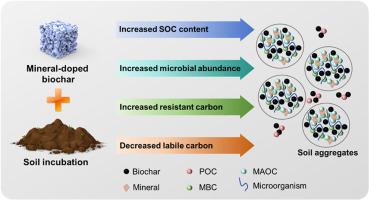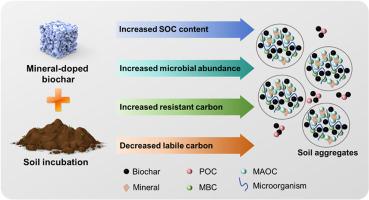掺矿生物炭对土壤固碳的影响:土壤团聚体和微生物群落的作用
IF 10
1区 环境科学与生态学
Q1 ENGINEERING, ENVIRONMENTAL
引用次数: 0
摘要
生物炭具有固有的稳定性和多孔结构,通过减少矿化和增加碳输入来保持土壤有机碳(SOC),但其机制尚存在知识空白。本研究制备了掺粉煤灰和煤矸石的生物炭(FA/BC和CG/BC),并通过土壤培养研究了FA/BC和CG/BC对土壤碳组分的影响。结果表明,矿物掺杂显著提高了生物炭的产率(比初始生物炭高6%),促进了多孔结构的形成,促进了无定形碳向石墨结构的转变,从而提高了抗氧化能力(减少了约17.5%的碳损失)和热稳定性(增加了1.5% - 6.8%的碳保留)。FA/BC和CG/BC提高了土壤水解酶活性,增强了土壤团聚体的结构和稳定性,降低了溶解有机质的生物有效性。添加量为2.3%的CG/BC对土壤有机碳的影响最好,微生物量碳、颗粒性有机碳和矿物伴生有机碳分别增加138.2、3.5和0.5 mg/kg,溶解性有机碳减少48.9 mg/kg。宏基因组学结果表明,生物炭对土壤微生物多样性有积极影响,增加了碳降解基因和soc降解酶的丰度,促进了微生物生物量碳的积累。综上所述,CG/BC提高了土壤团聚体的结构和稳定性,增加了土壤有机碳(SOC)含量,提高了功能微生物的丰度,从而促进了稳定SOC的形成。结果表明,掺矿物生物炭具有良好的固碳潜力。本文章由计算机程序翻译,如有差异,请以英文原文为准。


Carbon sequestration in soil affected by mineral-doped biochar: Roles of soil aggregate and microbial community
Biochar's inherent stability and porous structure contribute to soil organic carbon (SOC) preservation by reducing mineralization and enhancing carbon input, but there are still knowledge gaps of the mechanism. This study prepared biochar doped with fly ash and coal gangue (FA/BC and CG/BC) and investigated the effects of FA/BC and CG/BC on soil carbon components through soil incubation. The results indicated that mineral doping significantly increased the biochar yield (6 % more than initial biochar), facilitated porous structure formation, promoted the transformation of amorphous carbon into graphitic structure, thereby improving the antioxidant capacity (approximate 17.5 % less carbon loss) and thermal stability (1.5 %–6.8 % more carbon retention). FA/BC and CG/BC improved soil hydrolase activity, enhanced the structure and stability of soil aggregates, as well as reduced the bioavailability of dissolved organic matter. CG/BC with the content of 2.3 % exhibited the best effect on soil organic carbon, which increased microbial biomass carbon, particulate organic carbon and mineral-associated organic carbon by 138.2, 3.5 and 0.5 mg/kg, respectively, and decreased dissolved organic carbon by 48.9 mg/kg. According to Metagenomics results, biochar had a positive effect on soil microbial diversity, increasing the abundance of carbon-degrading genes and SOC-degrading enzymes that contributed to the accumulation of microbial biomass carbon. Overall, these above findings demonstrate that CG/BC enhances the structure and stability of soil aggregates, increases soil organic carbon (SOC) content, and elevates the abundance of functional microorganisms, thereby promoting the formation of stable SOC. The results emphasizes that mineral-doped biochar exhibits excellent carbon sequestration potential.
求助全文
通过发布文献求助,成功后即可免费获取论文全文。
去求助
来源期刊

Journal of Cleaner Production
环境科学-工程:环境
CiteScore
20.40
自引率
9.00%
发文量
4720
审稿时长
111 days
期刊介绍:
The Journal of Cleaner Production is an international, transdisciplinary journal that addresses and discusses theoretical and practical Cleaner Production, Environmental, and Sustainability issues. It aims to help societies become more sustainable by focusing on the concept of 'Cleaner Production', which aims at preventing waste production and increasing efficiencies in energy, water, resources, and human capital use. The journal serves as a platform for corporations, governments, education institutions, regions, and societies to engage in discussions and research related to Cleaner Production, environmental, and sustainability practices.
 求助内容:
求助内容: 应助结果提醒方式:
应助结果提醒方式:


